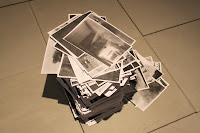Frequently I am asked at work to do some maintenance and painting after the kids have finished on rides and just before it starts to get dark. Previously I have repaired, sanded and painted the top of the bandstand at The Worthing Lido. Last year I also painted a fruit bowl upon the top of the roof. I have been carrying on with the second every so often. The photograph below shows my progress do far.
 |
| The second fruit bowl on the East side nearing completion. |
The other day I was asked to complete an fill in the worthing motto in Latin. It had been displayed as part of the emblem on a side wall facing the pier. It has also been painted before but parts had come off, so i was asked to go over it as best as I could. As soon as I looked at the wall I could see that It had been rushed previously and hence lettering was wrong in the style of Times New Roman. I got to work and just had to make do with what was there.
Just before finishing the last word in Latin I saw a man looking over me, and approached me by saying; "You do know you have done the letters wrong". I knew exactly what he meant. The previous person had done the letters such as "X" and "M" with the bold line first and the thin line second. (It's a bit hard to explain)
Anyway I had an inspirational ten minute talk with this guy about calligraphy and graphic design. He asked me whether I was a professional and I told him that I was still in education and planning to go to university next year. He recommended looking at SCAT, Somerset College of Arts and Technology as that was where he went when he was younger. I expect this bloke was retired now.
From carrying on talking personal he kept asking me questions if I had heard of Company's such as WPP, a leading advertising and marketing service that he used to work for. I was fascinated and truly inspired by his words. This guy next went on to say that his last piece of work he was commissioned for was a font for a bottle. He went on to tell me that he was the guy who created the label font for San Miguel and Cobra beers.
I had loved talking to this bloke and could have talked to him for hours. Sadly he had to go because his wife was waiting for him. He shock my hand and told me his name was Bob. A fascinating day and I was astonished how successful he had been.








